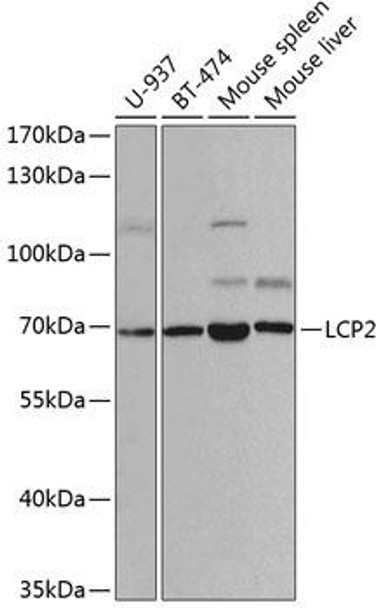Cell Biology Antibodies 8
Anti-LCP2 Antibody (CAB2567)
- SKU:
- CAB2567
- Product Type:
- Antibody
- Reactivity:
- Human
- Reactivity:
- Mouse
- Host Species:
- Rabbit
- Isotype:
- IgG
- Research Area:
- Cell Biology
Description
| Antibody Name: | Anti-LCP2 Antibody |
| Antibody SKU: | CAB2567 |
| Antibody Size: | 20uL, 50uL, 100uL |
| Application: | WB |
| Reactivity: | Human, Mouse |
| Host Species: | Rabbit |
| Immunogen: | Recombinant fusion protein containing a sequence corresponding to amino acids 284-533 of human LCP2 (NP_005556.1). |
| Application: | WB |
| Recommended Dilution: | WB 1:500 - 1:2000 |
| Reactivity: | Human, Mouse |
| Positive Samples: | U-937, BT-474, Mouse spleen, Mouse liver |
| Immunogen: | Recombinant fusion protein containing a sequence corresponding to amino acids 284-533 of human LCP2 (NP_005556.1). |
| Purification Method: | Affinity purification |
| Storage Buffer: | Store at -20'C. Avoid freeze / thaw cycles. Buffer: PBS with 0.02% sodium azide, 50% glycerol, pH7.3. |
| Isotype: | IgG |
| Sequence: | KPPL PPTT ERHE RSSP LPGK KPPV PKHG WGPD RREN DEDD VHQR PLPQ PALL PMSS NTFP SRST KPSP MNPL PSSH MPGA FSES NSSF PQSA SLPP YFSQ GPSN RPPI RAEG RNFP LPLP NKPR PPSP AEEE NSLN EEWY VSYI TRPE AEAA LRKI NQDG TFLV RDSS KKTT TNPY VLMV LYKD KVYN IQIR YQKE SQVY LLGT GLRG KEDF LSVS DIID YFRK MPLL LIDG KNRG SRYQ CTLT HAAG YP |
| Gene ID: | 3937 |
| Uniprot: | Q13094 |
| Cellular Location: | Cytoplasm |
| Calculated MW: | 60kDa |
| Observed MW: | 70kDa |
| Synonyms: | LCP2, SLP-76, SLP76 |
| Background: | SLP-76 was originally identified as a substrate of the ZAP-70 protein tyrosine kinase following T cell receptor (TCR) ligation in the leukemic T cell line Jurkat. The SLP-76 locus has been localized to human chromosome 5q33 and the gene structure has been partially characterized in mice. The human and murine cDNAs both encode 533 amino acid proteins that are 72% identical and comprised of three modular domains. The NH2-terminus contains an acidic region that includes a PEST domain and several tyrosine residues which are phosphorylated following TCR ligation. SLP-76 also contains a central proline-rich domain and a COOH-terminal SH2 domain. A number of additional proteins have been identified that associate with SLP-76 both constitutively and inducibly following receptor ligation, supporting the notion that SLP-76 functions as an adaptor or scaffold protein. Studies using SLP-76 deficient T cell lines or mice have provided strong evidence that SLP-76 plays a positive role in promoting T cell development and activation as well as mast cell and platelet function. |
| UniProt Protein Function: | SLP76: an adaptor protein involved in signaling through the T cell antigen receptor complex and signaling in other hematopoietic lineages including platelets. Originally identified as a substrate of the ZAP-70 protein tyrosine kinase following T cell receptor (TCR) ligation. Platelets deficient in SLP76 do not couple GPVI engagement with the signaling cascade that induces degranulation and aggregation in response to collagen. Contains four domains: a COOH-terminal SH2 domain, a central proline-rich domain, an NH2-terminal sterile {alpha} motif domain, and acidic region that contains three tyrosine phosphorylation motifs: Y112ESP, Y128ESP, and Y145EPP. pY112 and pY128 bind SH2 domains of Vav and Nck. pY145 is recognized by SH2 domains of the Tec family kinases Itk and Btk. Highly expressed in spleen, thymus, peripheral blood leukocytes, mast cells, platelets, and T-cell and monocytic cell lines. Expressed at lower level in B-cell lines. Not detected in fibroblast or neuroblasatoma cell lines. |
| UniProt Protein Details: | Protein type:Adaptor/scaffold Chromosomal Location of Human Ortholog: 5q35.1 Cellular Component: cytosol Molecular Function:protein binding Biological Process: immune response; platelet activation; positive regulation of protein kinase activity; T cell receptor signaling pathway; transmembrane receptor protein tyrosine kinase signaling pathway |
| NCBI Summary: | SLP-76 was originally identified as a substrate of the ZAP-70 protein tyrosine kinase following T cell receptor (TCR) ligation in the leukemic T cell line Jurkat. The SLP-76 locus has been localized to human chromosome 5q33 and the gene structure has been partially characterized in mice. The human and murine cDNAs both encode 533 amino acid proteins that are 72% identical and comprised of three modular domains. The NH2-terminus contains an acidic region that includes a PEST domain and several tyrosine residues which are phosphorylated following TCR ligation. SLP-76 also contains a central proline-rich domain and a COOH-terminal SH2 domain. A number of additional proteins have been identified that associate with SLP-76 both constitutively and inducibly following receptor ligation, supporting the notion that SLP-76 functions as an adaptor or scaffold protein. Studies using SLP-76 deficient T cell lines or mice have provided strong evidence that SLP-76 plays a positive role in promoting T cell development and activation as well as mast cell and platelet function. [provided by RefSeq, Jul 2008] |
| UniProt Code: | Q13094 |
| NCBI GenInfo Identifier: | 10720065 |
| NCBI Gene ID: | 3937 |
| NCBI Accession: | Q13094.1 |
| UniProt Secondary Accession: | Q13094,Q53XV4, A8KA25, |
| UniProt Related Accession: | Q13094 |
| Molecular Weight: | 60188 Da |
| NCBI Full Name: | Lymphocyte cytosolic protein 2 |
| NCBI Synonym Full Names: | lymphocyte cytosolic protein 2 |
| NCBI Official Symbol: | LCP2 |
| NCBI Official Synonym Symbols: | SLP76; SLP-76 |
| NCBI Protein Information: | lymphocyte cytosolic protein 2 |
| UniProt Protein Name: | Lymphocyte cytosolic protein 2 |
| UniProt Synonym Protein Names: | SH2 domain-containing leukocyte protein of 76 kDa; SLP-76 tyrosine phosphoprotein; SLP76 |
| Protein Family: | Larval cuticle protein |
| UniProt Gene Name: | LCP2 |
| UniProt Entry Name: | LCP2_HUMAN |
View AllClose







